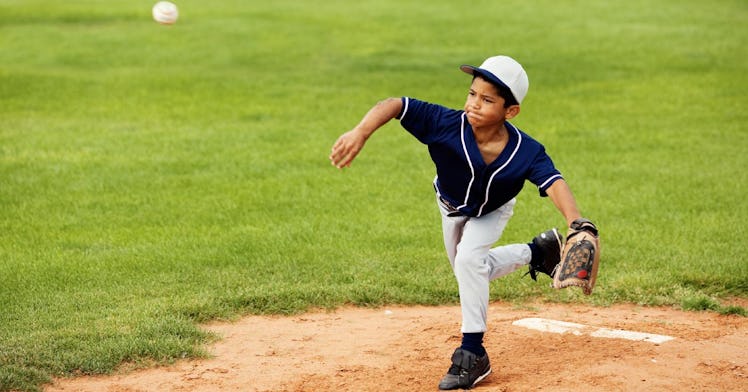A “Tommy John” Surgery Specialist’s Advice For Little League Pitchers
Dr. Timothy Kremchek, team doctor for the Cincinnati Reds, offers advice on pitch counts and the dangers of curveballs.

One of the biggest arguments on the Little League field over the past few seasons has nothing to do with players being safe or out but when and what pitchers should throw. First, there’s the whole curveball debate and whether or not kids younger than 12 should toss such stinky cheese. Then there’s the total pitch count predicament and what the cap should be on balls thrown for pre-pubescent pitchers. They’re good arguments to have because excessive or improper pitching can lead to serious injury.
For advice we turned to Dr. Timothy Kremchek, a man who understands the ache of an overused throwing arm. An Ohio-based orthopedic surgeon who serves as team doctor for the Cincinnati Reds, Kremchek regularly repairs the busted shoulders and elbows of pitchers. In fact, he’s performed more than 1000 Tommy John surgeries in his career. And although on-call with the majors, Kremchek most commonly treats younger clientele — youth players, most often pitchers, suffering from injuries that stem from improper form or, most commonly, years of overuse. Kremchek offered advice all parents should know about arm health, pitch counts, and the dangers of curves.
Start ‘Em Young
Contrary to what you might think after watching your toddler fling peas across the kitchen, throwing is not a natural act. And that’s why Kremchek stresses that all parents should teach kids — athletes or not — to practice the motion as early as possible. Practice makes perfect, yes, but it also prevents injury: the more a kid throws from a young age, the more the muscles and bones of the shoulder adapt and become stronger for a life spent on a dirt clod, spitting out sunflower seeds, and squinting at a catcher’s crotch. “You’ll see some adaptive changes that help them down the road,” he says.
Form Leads to Function
Proper pitching form requires a complex chain of events in the body that begins with the legs, hips, and ass. Incorporating the lower body not only helps pitchers throw harder, yes, but to throw without twisting the hips and ass leads to more blow-outs than a Bayonne deli line. “The lower body takes significant stress off the upper body,” Kremchek says. “And the ones who continue to throw hard without that technique have a higher incidence of elbow and shoulder problems.”
But here’s the rub: Kids don’t start to incorporate their lower body until later (per Kremchek this is roughly around 11 in girls and 13 in boys). So it’s up to you – or a proper trainer or coach – to teach wannabe Cy Youngs to incorporate proper mechanics before they start making serious moves to the mound.
Lay off the Curve
The curveball is always a point of contention with young kids. As much more torque is required to toss a breaking ball, many believe — Kremchek included — that it puts too much strain on young elbows. While studies don’t show much correlation between breaking balls and busted arms — a 2011 study from the University of North Carolina that evaluated the strain of pitching on more than 1,400 baseball players, 410 of which were Little Leaguers, showed no discernable conclusion between breaking balls and busted arms — Kremchek, who’s operated on many young elbows strained by the stresses of curves, says that young pitchers shouldn’t throw them until their bodies are developed That equals age 12 in girls and 13 in boys.
Count Those Pitches
Pitch counts exist for a reason – to keep players from overdoing their arms and to prevent batters from being beaned by balls thrown by fatigued pitchers. While Little League has a mandated pitch counts (50 pitches for 7 and 8-year-olds; 75 pitches for 9 and 10-year-olds; 85 for 11 and 12-year olds) Kremchek, however, thinks parents should keep count themselves because coaches often don’t enforce them. His formula: Six times the kid’s age, not including a warm up — so an 8-year-old should toss 48 pitches per game. After pitching, Kremchek says kids should stay off the field until the next day, i.e., no switching to shortstop, and take three days off before stepping foot on the mound.
Have Your Kid Play Multiple Sports
Year-round baseball leagues are everywhere. But allowing kids to play for a full year, says Kremchek, is a bad course of action. Summer leagues are notorious for letting kids pitch too much, he says, so it’s best for kids to sit some seasons out and to make them play at least one other sport— the cross training strengthens the body and improves athletic ability overall allowing a young body to be more adaptable to stress later on.
Besides, time off is time well spent. According to Kremchek, the pitchers with long, injury-free careers are those who didn’t overuse their arms when they were younger and avoided throwing breaking balls until they were 18 or 19. “The vast majority have had a calculated path to the big leagues without that abuse,” he says. “The guys who peter out in the minors were beaten up when they were younger.”
This article was originally published on